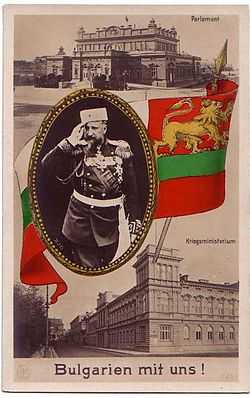Ovče Pole Offensive
| Ovche Pole Offensive | |||||||
|---|---|---|---|---|---|---|---|
| Part of Serbian Campaign (World War I) | |||||||
|
|||||||
| Belligerents | |||||||
| Commanders and leaders | |||||||
| Georgi Todorov | Damjan Popovic | ||||||
| Strength | |||||||
| 2nd Army- 100,247 men 53,325 rifles 52 machine guns 182 cannons[1] | 2- 3 divisions : 41,250 rifles 33 machine guns 78 cannons*[1] |
||||||
| Casualties and losses | |||||||
| Unknown | Heavy | ||||||
The Ovche Pole Offensive Operation (Bulgarian: Овчеполска настъпателна операция) was an operation of the Bulgarian Army that occurred between 14 October 1915 and 15 November 1915 as part of the Serbian Campaign in World War I. Its aim was to seize the valley of the river Vardar and to cut the vital railway linking Skopje with Thesaloniki to prevent the Serbian Army from being resupplied and reinforced by the Allied Expeditionary Force. The Bulgarian forces consisted of the Second Army (3rd Balkan Infantry Division, 7th Rila Division and the Cavalry Division with 182 guns) under the command of Lieutenant General Georgi Todorov.
The main blow was at Kumanovo where the Bulgarian 3rd and 7th divisions easily defeated the Serbian army. On the third day the Bulgarian Cavalry Division also advanced, defeating the Serbian counter-attack and reaching Veles and the Vardar. With this success the aim was achieved. While fighting against the Serbs, the Bulgarians defeated two French divisions in the Battle of Krivolak and conclusively cut the way between the Serbs and the Allies, resulting in the fall of Serbia after the Kosovo Offensive Operation in 1915.
References
Sources
- "Българската армия в Световната война 1915-1918",Том III;Държавна печатница София 1938.
Notes
- The number includes the Serbian forces located in Macedonia at the Albanian border on 13 October 1915 - 11,650 rifles,24 cannons and 12 machine guns.

